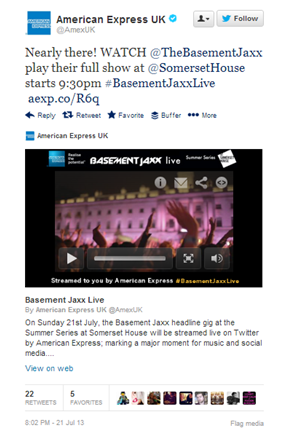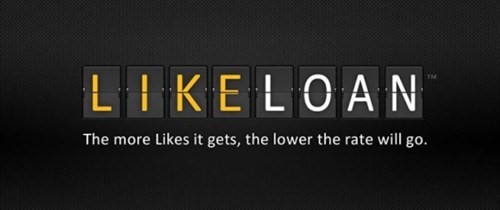Banking on social media innovation
22 July 2013
Innovation is a popular topic within the financial services industry, with organisations developing a number of digital solutions to meet the needs of today's digital consumer. Social media and financial services may seen as something of an oxymoron - the two don't usually go hand in hand, and when they do the result can be quite embarrassing. Believe it or not, there are some great social media innovations out there, which even brands in other industries can learn from.
American Express’ Basement Jaxx Gig
American Express is often considered to be an industry leader on social media, having established partnerships with Twitter and Foursquare as far back as two years ago. One of the company’s latest social media innovations was a tweet embedded with a live video stream of a Basement Jaxx gig, held at Somerset House:

Not only could Twitter users watch the gig online, they were able to tweet using #BasementJaxxLive and up to 10 requests would be read out by the music duo themselves, meaning fans unable to attend the gig were still able to get involved. Although not directly linked to financial services, the tweet demonstrates AmEx's commitment to delivering an exceptional customer experience.
Key takeaway: Your social content doesn’t necessarily need to have a direct link to the industry in which you operate. Providing there is some tie in with your brand and its values, you’re on the right track. American Express prides itself in offering a superior customer experience, and that is exactly what it has done here; enabling Basement Jaxx fans across the globe to get involved in a small concert.
First Direct Lab
Not using a social network per se, but a fantastic use of how developing a customer community can help First Direct deliver the products and services its customers want. Customers are invited to make suggestions about products and services, as well as test-drive and provide feedback on new ideas and innovations before they’re released. This is a great way of getting the end-user involved in product development, and can help First Direct ensure its products and services meet the needs of its customers.
Key takeaway: In many cases, your customers are your brand, so you need to involve them. Without your customers your brand probably wouldn’t exist. Building a community like this and getting the community involved in product development tells your customers you are listening to them. It makes them feel valued, and hopefully, they’ll want to continue using your products and services.
ASB “Like Loan”
Popular New Zealand bank ASB offered Facebook fans the opportunity to win a special home loan rate, based on the number of Likes the Page generates. The campaign increased Page Likes by 9% within the first week; driving the loan rate down to 2.5% (well below the advertised rate of 5.19%).

As well as increasing Likes on ASB’s Facebook Page, within the first week there were over 6,000 Facebook users talking about the app, and over 800 Facebook users shared the app on the first day of the promotion.
This is a great use of Facebook to promote banking products, and rewards the audience for their activity on Facebook. Furthermore, while other brands may offer unrelated rewards such as iPads, or similar, the reward is highly relevant for the financial services industry and ASB itself.
Key takeaway: This campaign is based around the Groupon model, while adding a twist which means ASB isn’t devaluing its brand too much; only one lucky fan receives a loan at the discounted rate. It’s a great way of driving Likes to the Facebook page in a simple way, and adds an element of fun to the campaign, as there’s no knowing how low the rate will go.
The bottom line:
Having a social media presence is becoming a necessity for financial services organisations. Customer confidence is at an all-time low, and the financial crisis and banking scandals have seriously damaged how the industry and many big players are perceived. Being social offers brands in any industry the opportunity to regain trust, and engage in multidimensional conversations with customers and prospects. Even if it’s just in a listening capacity, a good starting point is knowing what the public are saying about your brand and on which channels, so when you do take your first social media steps, you know what to expect, and where to be active.

